Jul 19, 2005
The Fifth International Conference on Gerontechnology
The fifth international conference on Gerontechnology took place in Nagoya May 24-27 2005. The slogan of the conference was "Technology for smart aging - For a long and happy life with health and self-esteem". The conference program included sessions like Universal Design, Mobility, Home care and Living, Health care and Robotics for Human Support. Topics like Work and Leisure were also treated.
Use of new information technology (IT) solutions was taken up in most of the presentations. The goal could be to provide elderly people with information about preventive care, help them get useful information when moving around outdoors or handling activities of daily living. It was shown that IT and Assistive Technology (AT) could be used to counteract the triggering factors that normally result in hospitalisation and long time care.
The Design for All and Inclusive design approaches were constantly referred to because it was shown that the elderly people had to be able to use new technology and services themselves. Use of Design for All or Inclusive design strategies and methods ensure that mainstream products, services and environments are accessible to the largest number of people.
Organiser of the conference was the International Society for Gerontechnology ISG.
More to explore:
Links to the conference abstracts:sts.bwk.tue.nl/gerontech/Full_text/Volume_3/nr_4/Contents...
12:32 Posted in Positive Technology events | Permalink | Comments (0) | Tags: Positive Technology
Vagus Nerve Stimulation System for Severe Depression
Via Medgadget
The Food and Drug Administration has recently approved a new treatment for severe depression based on a nerve stimulation system that delivers tiny electric shocks through vagus nerve and into a region of the brain thought to play a role in mood.
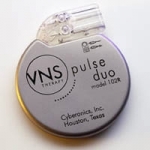 Cyberonics Inc.'s stimulation system is an adjunctive long-term treatment of chronic or recurrent depression for adults who are experiencing a major depressive episode that has not had an adequate response to two or more adequate antidepressant treatments.
Cyberonics Inc.'s stimulation system is an adjunctive long-term treatment of chronic or recurrent depression for adults who are experiencing a major depressive episode that has not had an adequate response to two or more adequate antidepressant treatments.
Despite controversy over whether it's really been proven to work, the potential treatment targets an estimated 4 million Americans with hard-to-treat depression.
12:00 Posted in Brain-computer interface | Permalink | Comments (0) | Tags: Positive Technology, brain-computer interface
Wearable technology promotes the well-being of the elderly
A Finnish IST International Security Technology has developed a well-being wristband called Vivago™, which analyses and transmits information on the user's level of activity and notifies if any deviations from normal occur. The wristband is intended to allow elderly or chronically ill person to continue independent living securely at home. 
When using the wristband for the first time, it measures the user's normal level of activity. Later on, if the wristband observes anything that deviates from the normal level of activity, it automatically sends a notification to the recipient of alarms, which may be a community nursing centre.
10:40 Posted in Wearable & mobile | Permalink | Comments (0) | Tags: Positive Technology, wearable
Jul 18, 2005
Philips' iCat for studying human-robot interaction topics
Via Medgadget
Philips new invention iCat promises to advance the field of human-robot interaction. The robot can express a wide range of expressions, and elaborate the user's reactions to these expressions. The robot is about fourty cm tall and is equipped with a number of servos that control different components of the face, including mouth and head position. Moving these parts of the face, the robot can make many different facial expressions. Reseachers can observe the user's reaction to these expressions and investigate i.e. the perceived personality of the iCat during a game or task setting.

Philips researchers predict that the iCat could have applications in psychology research (social cognition) and in medicine, for example to help autistic children or stroke survivors.
More to explore
- the Philips Research Technologies web page
19:40 Posted in AI & robotics | Permalink | Comments (0) | Tags: Positive Technology, robotics
Jul 16, 2005
Video games for health
Video games have been often criticized by for their negative psychological effects on children. However, a growing number of studies show that video game playing can be useful in health. In an editorial published on the authoritative British Medical Journal, Mark Griffiths, professor of gambling studies, describes how video games are used in health care. One innovative application is their use in pain management. The attention needed to play can distract the player from the sensation of pain, a strategy that has been reported and evaluated among paediatric patients.
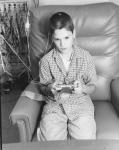
Video games have also been used as a form of physiotherapy or occupational therapy in many different groups of people. Such games focus attention away from potential discomfort and, unlike more traditional therapeutic activities, they do not rely on passive movements and sometimes painful manipulation of the limbs.
Read the full-text article published on BMJ (2005;331:122-123)
12:50 Posted in Cybertherapy | Permalink | Comments (0) | Tags: Positive Technology, virtual reality therapy
Jul 07, 2005
Virtual sky helps patients to relax during cancer radiation therapy
Via the Presence Listserv
Mercy Therapeutic Radiology Associates use manmade skyscape to provide a comfortable ambience during radiation therapy. The images help patients relax and lie still during treatments. 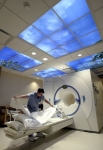
The manmade skyscape, called a SkyCeiling, is produced by Fairfield-based company called the Sky Factory. The circular SkyCeiling features a pale sliver of a moon hanging against a deep blue sky, tree branches speckled with bright green leaves and gauzy white clouds.
Mercy Therapeutic Radiology has three SkyCeilings, the first installed in late 2003. The hospital also invested in three virtual windows made by the Sky Factory, with landscapes that use a window as the point of reference.
Each virtual window costs $2,000 to $3,000. The ceiling murals cost from $3,000 to $13,000.
11:40 Posted in Emotional computing | Permalink | Comments (0) | Tags: Emotional technology
Jul 05, 2005
Accupix MP Glass MPG-230A HMD Video Glasses - Get Your Mobile Presence Experience
Wow. This is really cool stuff. The Accupix MP glass MPG-230A Video Glasses and portable player are maybe the best example of next-generation virtual reality systems. This technology enables the vision of "mobile presence": your body is in a physical space, but your mind is somewhere else. Imagine you're on the tube, bored and frustrated. Wou desperetely desire to escape from there, and experience five minute of peaceful relax. You have just to wear your portable immersive headset, and bon voyage.
There are many Positive applications that we can imagine using this technology, ranging from "traditional" virtual-reality based treatment to mobile telemedicine applications.
The system is also quite affordable (649$) as compared to traditional HMD.
If you want to know more, read the technical review by Ken Wold for I4U:
| Overview |
15:20 Posted in Wearable & mobile | Permalink | Comments (0) | Tags: Positive Technology, wearable
Jun 29, 2005
Bionic Arm Technology is advancing
From Medgadget
Mr. Jesse Sullivan is the world's first "Bionic Man", according to the Rehabilitation Institute of Chicago (RIC). In May 2001, Mr. Sullivan lost both of his upper extremities as a result of an accident. The technology that allows this patient to control his artificial arms has been developed by RIC's Neural Engineering Center for Artificial Limbs (NECAL).
Developed within the Neural Engineering Center for Artificial Limbs (NECAL) at RIC, Dr. Todd Kuiken, MD, PhD, pioneered the muscle reinnervation procedure which takes an amputee's own nerves and connects them to a healthy muscle. In this case, four of Mr. Sullivan's nerves were dissected from the shoulder and transferred to the muscles of his chest. Doing so allows the user to move his or her prosthetic arm as if it were a real limb--by simply thinking about what they want the arm to do. The "Bionic Arm," or myoelectric arm, is driven using electrical signals from the muscles of the chest, now activated by the user's own thought-generated nerve impulses. These impulses are sensed, via surface electrodes, from the pectoral muscle and carried through to the mechanical arm, causing the arm to move.
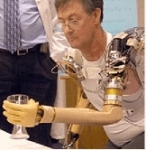
NECAL uses nerve-muscle grafts in amputees to gain added control signals for an artificial arm. Doctors take nerves that used to go to the arm and move those nerves onto chest muscles. The nerves grow into the chest muscles, so when the patient thinks "close hand," a portion of his chest muscle contracts and electrodes that detect this muscle activity tell the computerized arm when to close the hand. Thus, the patient thinks "close hand" and his artificial hand closes...
Researchers at RIC have learned that although the limb is lost with an amputation, the control signals to that limb remain accessible in the residual peripheral nerves. Grafting the residual nerves of an upper-limb amputee to spare muscles produces additional control signals, allowing for simultaneous operation of multiple functions in an externally powered prosthesis with a more natural feel than is possible with conventional prostheses.
The "Bionic Arm" technology has been very successful so far in both significantly improving the function of artificial limbs as well as allowing the skin to be reinnervated with nerves form the arm. The first patient to undergo the new procedure, Jesse Sullivan, has experienced significant improvements in the functioning of his prosthetic arms. While previously moving his artificial arms was slow and cumbersome, today he is able to do many of the routine tasks he took for granted before his accident, including putting on socks, shaving, eating dinner, taking out the garbage, carrying groceries and vacuuming.
18:35 Posted in Brain-computer interface | Permalink | Comments (0) | Tags: brain-computer interface
Jun 27, 2005
Tennis for the visually impaired
From Near near future
Tennis Sensation is a tennis game that allows a wide variety of users, particularly the visually impaired, to compete fairly.
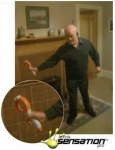
It uses spatial (3D) audio, to represent sounds at locations in space, enabling the user to locate the virtual ball. The handle of the "racquet" shows correct orientation and grip through contours and materials.
Skill and physical ability can be altered to allow use by the elderly and disabled. A handicapping level selection enables a grandparent to play with their grandchild. The game can be played by people in different locations. When gripped from the charger the product turns on and connects to the headphones automatically. It can connect through an internet connection or use the 3G phone network. Menus are navigated by tilting and options selected by squeezing the grip. Vibropads in the grip give the subtle vibrations associated with good and bad tennis shots, and haptics give the feel of a ball on the racquet at virtual impact. Banks of LEDs explode on impact, with colour representing the quality of the shot. A dedicated synthesiser generates the stereo sound and audio cues, and a Motorola RISC microprocessor performs the calculations.
13:15 Posted in Brain training & cognitive enhancement | Permalink | Comments (0) | Tags: Positive Technology, Cognitive prosthetics
Jun 21, 2005
As time goes by - New Memory Aid Helps Dementia Sufferers
Press release - Engineering and Physical Sciences Research Council (EPSRC)
PN: 14/05
Issue date: 15 June 2005
Classic movies such as ‘Casablanca’ could bring back lost memories for dementia sufferers thanks to an innovative memory aid.
Ladies Sweeping
The CIRCA system provides old photographs, video footage and music to help dementia sufferers remember the past and engage in conversation with their carers
Based on an interactive multimedia computer system and a clearer understanding of how dementia sufferers respond to social situations, the aid aims to stimulate more enjoyable, rewarding conversation between sufferers and those who care for them.
With funding from the Engineering and Physical Sciences Research Council (EPSRC), a team of researchers in Scotland has developed CIRCA (Computer Interactive Reminiscence and Conversation Aid). CIRCA comprises a simple touch-screen with easy-to-follow instructions that require no IT competence.

When switched on, it displays a choice of three random categories (entertainment, local life etc). Selecting a category, the user is given a choice of ‘music’, ‘photo’ or ‘video’. These in turn call up images, video or sound clips (e.g. of well-known movie stars such as Humphrey Bogart) from a database, acting as a memory trigger and conversation prompt. A ‘stop and talk’ button allows the system to be frozen at any point.
The research team has built a range of innovative features into the way the system is used. Because sufferer and carer sit side by side in front of the screen, encouraging the sense of a shared experience, and because the system relies on a touch screen, rather
Radio
While the current system draws on images and sounds from the 1930's to the 1960's the content could be tailored to reflect the sort of material likely to appeal to any age group
than a mouse or keyboard, the carer is not seen as being ‘in control’. Furthermore, as the sufferer can be prompted to operate the system themselves, they feel less dependent on their carer. The result is a more positive, relaxed social experience than can be achieved using other memory-prompting reminiscence packages currently available.
During development, CIRCA was tested on 40 dementia sufferers in daycare, nursing home and family situations. The results were very encouraging, with many carers reporting that sufferers seemed like their ‘old self’ (see case studies below). CIRCA exploits the fact that, while dementia sufferers find it hard to recall recent events, longer-term memory is less affected by their condition.
CIRCA could become available on the market in 2-3 years. The research team is now looking at whether it could also be used for people with learning disabilities or head injuries. In addition, they have secured EPSRC funding to develop an interactive multimedia activity system that dementia sufferers can use on their own.
Dr Arlene Astell of the University of St Andrews School of Psychology is leading the research team. Dr Astell says: "Dementia sufferers’ declining ability to hold normal conversations causes a lot of stress and frustration. Helping them access their memories will make living with dementia more bearable and less distressing for sufferers and their carers.”
00:00 Posted in Brain training & cognitive enhancement | Permalink | Comments (0) | Tags: Cognitive prosthetics
May 31, 2005
Hearing colors: the Eye-borg
HMC Entertainment Systems have invented a new device called the Eye-Borg that allows people with visual impairments and even total blindness to experience the world in colour. This system has the added effect of turning them into cyborgs, or, more accurately Eye-Borgs.
The Eye-Borg project started when Adam Montandon gave a lecture on practical cyborg techniques and applications. He was approached by Neil Harbisson, a young student artist. 
Neil had a rare condition of achromatopsia (a rare hereditary vision disorder which affects 1 person in 33,000). One of the effects of achromatopsia is monochromatism, the inability to perceive colour. To him the world was black and white.
Fast Moving Energies
Neil’s only comprehension of colours were as “being an energy that I can’t see because it moves too quickly. I’ve imagined colours as fast moving energies”. Neil became curious as to the possibilities of a cyborg-like extension of his sensory system. A new input based prosthesis!
Adam built a system that would effectively hijack Neil’s other senses by allowing him to see colour through his ears. It works with a head mounted camera that reads colours directly in front of a person, and converts them in real-time, via a computer, into sound waves.
Surprisingly, within 15 minutes of Neil using the system he was able to instantly recognise similarities and differences between hues – something he had never previously been able to do.
Neil is now able to paint with a full spectrum of colors incredibly accurately, as he wears his Eye-Borg prosthesis 24 hours a day. HMC aim to develop the Eye-Borg further so that all colour-blind or partially sighted people can experience a new clarity of digital vision.
17:55 Posted in Positive Technology events | Permalink | Comments (0) | Tags: Positive Technology
May 11, 2005
Presence 2005 Conference
The 8th Annual International Workshop on Presence will be held at University College London, September 21-23.
The deadline for receipt of papers, short-papers, posters, panels, exhibition items is 6th June.
Up to 20 papers will be published in a special issue of Presence: Teleoperators and Virtual Environments (MIT Press).
See
http://www.temple.edu/ispr/conference/ for full details.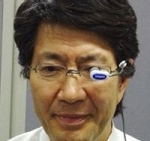
21:15 Posted in Positive Technology events | Permalink | Comments (0) | Tags: Positive Technology
Apr 28, 2005
Brain-machine Interface Test Promising
From Betterhumans
An experimental brain-machine interface has allowed a quadriplegic person to control a computer in what could be an early step to new assistive technologies for the disabled.
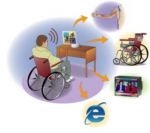
Cyberkinetics of Foxborough, Massachusetts has reported preliminary results for a pilot study of its BrainGate Neural Interface System, which the company aims to develop into a safe, effective and unobtrusive universal operating system for allowing disabled people to control devices using their thoughts.
"While these results are preliminary, I am extremely encouraged by what has been achieved to date," says study investigator Jon Mukand of Sargent Rehabilitation Center. "We now have early evidence that a person unable to move their arms, hands and legs can quickly gain control of a system which uses thoughts to control a computer and perform meaningful tasks. With additional development this may represent a significant breakthrough for people with severe disabilities."
Mental link
BrainGate, in a pilot study under a US Food and Drug Administration Investigational Device Exemption, uses an implanted neural signal sensor and external processors to allow users to control machinery.
The implanted sensor is about the size of a baby aspirin and contains 100 electrode probes thinner than a human hair. Implanted in part of the brain responsible for movement, the primary motor cortex, the probes detect the electrical activity of brain cells and relay this through a small wire exiting the scalp to a pedestal on the skull. A cable runs from the pedestal to a cart with computers, signal processors and monitors, allowing operators to study how well users can control their neural output.
For the reported study, an unidentified quadriplegic person with a three-year-old spinal cord injury had the sensor implanted this June in an approximately three-hour operation at Rhode Island Hospital in Providence. The procedure reportedly went as planned and the recipient has reportedly experienced no side-effects or problems healing.
Interactive mind
The study examined the recipient's use of BrainGate over two months and 20 study sessions. It found that the recipient could immediately adjust neural output in response to commands. It also found that a computer interface developed using the patient's thoughts allowed the subject to perform tasks and operate basic computer functions, including controlling a cursor, playing Pong with 70% accuracy and performing multiple tasks simultaneously, such as controlling a TV while talking.
While the findings are preliminary and based on a single patient, Cyberkinetics aims to enroll a total of five quadriplegic people between the ages of 18 and 60 who meet such criteria as being able to verbally communicate.
Each participant is expected to participate in a study for 13 months. Afterwards, participants can undergo surgery to have the device removed or choose to participate in future studies, which the first patient has chosen to do.
"Our ultimate goal is to develop the BrainGate System so that it can be linked to many useful devices, including for example, medical devices such as muscle stimulators, to give the physically disabled a significant improvement in their ability to interact with the world around them," says John Donoghue, chief scientific officer of Cyberkinetics.
The research was reported in Phoenix, Arizona at the 2004 annual meeting of the American Academy of Physical Medicine and Rehabilitation.
Cyberkinetics plans to announce more results and observations from the pilot study in San Diego, California at the 2004 annual meeting of the Society for Neuroscience.
14:45 Posted in Brain-computer interface | Permalink | Comments (0) | Tags: Positive Technology, brain-computer interface
Apr 18, 2005
Samsung mobile phone uses alpha waves to improve brain memory
From I4U
Samsung introduces the SCH-S350 mobile phone that uses apparently alpha waves to improve brain memory and concentration. This could be straight out of a sci-fi novel, but it is not. It is from a Samsung press-release.
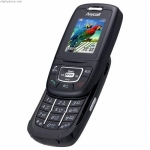
Samsung argued that alpha waves, known to improve memory and concentration, are generated when the phone plays functional music.
The Samsung SCH-S350 is a small slider phone featuring a 0.3MP digital camera, MP3 Player and GPS. The new Samsung mobile phone measures 85mm in length and weighs only 85g.
13:20 Posted in Meditation & brain | Permalink | Comments (0) | Tags: meditation
Apr 13, 2005
Rescue Robots
Disaster rescue is one of the most serious social issues which involves very large numbers of heterogeneous agents in an hostile environment.
Rescue Robotics is a newly emerging field dealing with systems that support first response units in disaster missions. Especially mobile robots can be highly valuable tools in urban rescue missions after catastrophes like earthquakes, bomb- or gas-explosions or daily incidents like fires and road accidents involving hazardous materials. The robots can be used to inspect collapsed structures, to assess the situation and to search and locate victims.
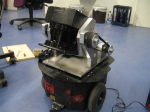
There are many engineering and scientific challenges in this domain. Rescue robots not only have to be designed for the harsh environmental conditions of disasters, but they also need advanced capabilities like intelligent behaviors to free them from constant supervision by operators.
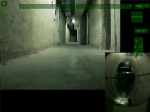
The main goal of the RoboCupRescue project is to promote research and development in this socially significant domain at various levels involving multi-agent team work coordination, physical robotic agents for search and rescue, information infrastructures, personal digital assistants, a standard simulator and decision support systems, evaluation benchmarks for rescue strategies and robotic systems that are all integrated into a comprehensive systems in future.
More to explore
The web site of RescueRobots Freiburg, one of the leading lab in the RR field
13:00 Posted in AI & robotics | Permalink | Comments (0) | Tags: Positive Technology, robotics
Apr 12, 2005
8th Annual International Workshop on Presence
Call for Papers
PRESENCE 2005 8th Annual International Workshop on Presence
London, England September 21-23, 2005
Submission deadline: June 6, 2005
Full details on the web at http://ispr.info
OVERVIEW
Academics and practitioners with an interest in the concept of (tele)presence are invited to submit their work for presentation at PRESENCE 2005 at University College London in London, England, September 21-23, 2005.
The eighth in a series of highly successful international workshops, PRESENCE 2005 will provide an open discussion forum to share ideas regarding concepts and theories, measurement techniques, technology, and applications related to presence, the psychological state or subjective perception in which a person fails to accurately and completely acknowledge the role of technology in an experience, including the sense of 'being there' experienced by users of advanced media such as virtual reality.
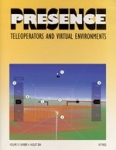
The concept of presence in virtual environments has been around for at least 15 years, and the earlier idea of telepresence at least since Minsky's seminal paper in 1980. Recently there has been a burst of funded research activity in this area for the first time with the European FET Presence Research initiative. What do we really know about presence and its determinants? How can presence be successfully delivered with today's technology?
This conference invites papers that are based on empirical results from studies of presence and related issues and/or which contribute to the technology for the delivery of presence. Papers that make substantial advances in theoretical understanding of presence are also welcome. The interest is not solely in virtual environments but in mixed reality environments. Submissions will be reviewed more rigorously than in previous conferences. High quality papers are therefore sought which make substantial contributions to the field.
Approximately 20 papers will be selected for two successive special issues for the journal Presence: Teleoperators and Virtual Environments.
PRESENCE 2005 takes place in London and is hosted by University College London. The conference is organized by ISPR, the International Society for Presence Research and is supported by the European Commission's FET Presence Research Initiative through the Presencia and IST OMNIPRES projects and by University College London.
TOPICS
Submissions of papers, demonstrations, and panels that represent completed or ongoing work are encouraged in areas including but not limited to:
* Explications of the presence concept
* Presence evaluation/measurement methodologies
* Causes and consequences (effects) of presence
* Presence in shared virtual environments and online communities
* Social/affective interfaces, virtual agents, parasocial interactions
* Presence-associated technologies:
- Immersive, interactive, multimodal displays
- Advanced broadcast and cinematic displays (stereoscopic TV, HDTV, IMAX)
- Virtual environments/simulators
- 3-D sound
- Haptic/tactile displays
* Presence applications:
- Education and training
- Medicine and therapy
- Entertainment
- Communication and collaboration
- Teleoperation
- Presence and design
- Presence in art
* Presence and philosophical issues (e.g., the nature of 'reality')
* The ethics of presence
* Presence in the future: Media experiences in the 21st century and beyond
CONFERENCE FORMAT
Like the earlier workshops, PRESENCE 2005 will have an interactive format in which all participants (attendees, presenters, invited speakers) attend each of the sessions as well as several social events, allowing participants to exchange ideas and build knowledge together as the conference progresses.
The conference will feature keynote presentations by three prominent presence scholars:
Paul Verschure (Institute of Neuroinformatics, University/ETH Zürich, Zurich, Switzerland)
Woody Barfield (Human Interface Technology Lab, University of Washington, Seattle, Washington, USA)
Carolina Cruz-Neira (Virtual Reality Applications Center, Iowa State University, Ames, Iowa, USA)
VENUE
The Workshop will be hosted by University College London
(UCL) in the Bloomsbury area in the heart of the great city of London.
For more information about London visit the official website for London (http://www.visitlondon.com/); for more information about UCL, visit the UCL web site (http://www.ucl.ac.uk).
SUBMISSIONS
We invite researchers and practitioners to submit work in the following categories:
Full papers: Comprehensive descriptions of original research or design work within the scope of the workshop. Full papers are limited to 12 pages in the PRESENCE 2005 template format (see submission page at http://ispr.info) and will be considered for oral presentation (unless the submitter requests consideration only for poster presentation).
Short papers: Brief presentation of tentative or preliminary results of research or design work within the scope of the workshop. Short papers are limited to 4 pages in the PRESENCE 2005 template format and will be considered for both oral presentation and poster presentation.
Posters: Visual display presentation. Submissions are limited to 4 A4 pages which contain miniature versions of the larger pages that would be displayed at the conference.
Demonstrations/exhibitions: Step-by-step audiovisual demonstrations and/or hands-on experiences of (commercial or academic) work within the scope of the workshop. Proposals for demonstrations/exhibitions are limited to 2 pages in the PRESENCE 2005 template format.
Panels: Sets of presentations on a single theme or topic within the scope of the workshop. Submitters are encouraged to be creative regarding both the topic and format of panel proposals, which are limited to 4 pages in the PRESENCE 2005 template format.
All submitted papers will be blind peer-reviewed by at least two selected reviewers. Work accepted for presentation will be included in the official conference proceedings and may be posted on the ISPR, presence-connect, and presence- research.org web sites prior to the conference. Authors of as many as 20 of the presented papers will be invited to revise their paper for publication in one of two special conference issues (August and October 2006) of the MIT Press journal Presence:
Teleoperators and Virtual Environments.
Please submit your work online at the submission page of the conference web site at http://ispr.info by the conference deadline of June 6, 2005.
19:55 Posted in Positive Technology events | Permalink | Comments (0)
Apr 08, 2005
!!! Groundbreaking virtual reality SONY patent - A step closer to the Matrix !!!
07 April 2005
Exclusive from New Scientist Print Edition
Jenny Hogan Barry Fox
Imagine movies and computer games in which you get to smell, taste and perhaps even feel things. That's the tantalising prospect raised by a patent on a device for transmitting sensory data directly into the human brain - granted to none other than the entertainment giant Sony.
The technique suggested in the patent is entirely non-invasive. It describes a device that fires pulses of ultrasound at the head to modify firing patterns in targeted parts of the brain, creating "sensory experiences" ranging from moving images to tastes and sounds. This could give blind or deaf people the chance to see or hear, the patent claims.

While brain implants are becoming increasingly sophisticated, the only non-invasive ways of manipulating the brain remain crude. A technique known as transcranial magnetic stimulation can activate nerves by using rapidly changing magnetic fields to induce currents in brain tissue. However, magnetic fields cannot be finely focused on small groups of brain cells, whereas ultrasound could be.
If the method described by Sony really does work, it could have all sorts of uses in research and medicine, even if it is not capable of evoking sensory experiences detailed enough for the entertainment purposes envisaged in the patent.

Details are sparse, and Sony declined New Scientist's request for an interview with the inventor, who is based in its offices in San Diego, California. However, independent experts are not dismissing the idea out of hand. "I looked at it and found it plausible," says Niels Birbaumer, a pioneering neuroscientist at the University of Tübingen in Germany who has created devices that let people control devices via brain waves.
The application contains references to two scientific papers presenting research that could underpin the device. One, in an echo of Galvani's classic 18th-century experiments on frogs' legs that proved electricity can trigger nerve impulses, showed that certain kinds of ultrasound pulses can affect the excitability of nerves from a frog's leg. The author, Richard Mihran of the University of Colorado, Boulder, had no knowledge of the patent until New Scientist contacted him, but says he would be concerned about the proposed method's long-term safety.
Sony first submitted a patent application for the ultrasound method in 2000, which was granted in March 2003. Since then Sony has filed a series of continuations, most recently in December 2004 (US 2004/267118).
Elizabeth Boukis, spokeswoman for Sony Electronics, says the work is speculative. "There were not any experiments done," she says. "This particular patent was a prophetic invention. It was based on an inspiration that this may someday be the direction that technology will take us."
More to explore
Virtual Reality
Transcranial Magnetic Stimulation
Matrix: the movie
Press releases
Australian IT - Sony patents 'real' Matrix
News24 - Sony eyes 'real-life Matrix'
Forbes.com - Sony takes first step to patent 'real-life Matrix
Dawn International - Real life Matrix in the making
Timesonline - Sony takes 3-D cinema directly to the brain
Australian Financial Review - First step to patent 'real-life Matrix'
14:25 Posted in Cybertherapy | Permalink | Comments (0) | Tags: Positive Technology, virtual reality
Apr 06, 2005
Remote healthcare monitoring not so distant
The IST programme funded-project developed a comprehensive monitoring system to capture, transmit and distribute vital health data to doctors, carers and family. Pilot tests of the E-Care system indicate that doctors, nurses, patients and their families found E-Care reliable, simple to use and an effective method to improve the quality of care while reducing costs.
E-Care’s system dynamically produces data depending who accesses a patient's record. A doctor will see all the health information, a system or medical administrator will see data relevant to them, while patients, their friends or family, will see another set of data, all coming from the one file.
The system will monitor patients with chronic, or long-term, illnesses such as diabetes or cardiovascular disease, and patients discharged after an operation or serious medical crises, such as stroke victims.
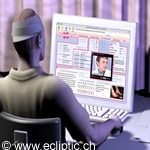
It can acquire vital information about a patient who lives far away from medical support, and it can alert medical staff if there is a dangerous change in patient's status. With e-Care’s system doctors spend less time going to see patients and more time treating them. It also means real-time monitoring without high staff or capital costs.
"Citizens with long-term illnesses as well as those who are in post-surgery state, or predisposed to illness, need monitoring of their health until their condition becomes stable," says E-Care project director Mariella Devoti.
"They, as well as their family and friends, also need an efficient way to collaborate with their doctor and get informed about their state. Until now, monitoring of the health condition of such people could only be accomplished by prearranged visits from a doctor, or by visits to the local hospital for a check-up. However, this is an inefficient solution, as well as costly, as these visits would scarcely be on a daily basis."
"[By] increasing the demand for long-term care, often at home, there are fewer facilities and medical staff available per patient," says Devoti. "This situation represents an important challenge for our society and it is urgent to provide consistent solutions to avoid a deep deterioration of the quality of life of millions of people."
Building a state-of-the-art remote monitoring system
Ten partners from Italy, Greece, the UK, Germany and Cyprus joined forces to develop a remote monitoring system that could take vital data from patients, automatically add the data to the patient's chart and render the information accessible via computer for analysis at a hospital or clinic.
"E-Care makes best use of state-of-the-art know-how from a wide spectrum of disciplines, ranging from medical devices and software to workflow management system, [which brings] experience from business modelling," Devoti says.
The system includes nine components deployed across two primary elements: patient monitoring and the central system.
On the patient side there's a wireless intelligent sensor network (WISE), bio-medical sensors and a radio terminal. WISE consists of a series of monitors that track signs like activity, temperature, pulse, blood pressure and glucose or other personal data like weight, pain measurement and drug conformance. Data collected by the sensors are sent to the transmitter that sends them to the central system.
But the system can work two ways. SMS messages sent to the drug conformance device to remind the patients when they need to take medication. Patients send a confirmation once they take the drugs.
The central system includes a medical data manager (MDM), E-Care repository, collaboration module, workflow system, security system and user Web applications.
The MDM automatically checks patient data against the patient's record and any doctor's notes. If there is a disturbing change in the patient's vital signs, for example high glucose levels in a diabetic, an alarm is sent directly to the patient's physician. This provides peace of mind for patient and family and ensures a doctor or medics can respond rapidly to any problems that arise. Similarly, the MDM can alert paramedical staff or a doctor if patient data fails to arrive when expected.
The E-Care repository stores all patient data. The collaboration module allows user to communicate using real-time synchronous message, audio conferencing or videoconference. Patients and family can confer with their doctor, or GPs or nurses can confer with a specialist.
The workflow system controls overall system processes, while user Web applications dynamically format the patient data depending on who is accessing the information and what access rights they have. Layouts for doctors, patients, system administrators, medical administrators and patient relatives, each with different information, are possible.
Researchers sought to avoid re-inventing the wheel by using standard and widely adopted technologies where possible. Transmission is across standard telecoms protocols such as GSM, 3G, bluetooth, radio and landline broadband. It means the system will work with any modern hospital or clinic.
Positive results from pilots
E-Care deployed in three pilot programmes between February 2003 and February 2004 and the overall result was very positive.
"The final validation results for E-Care showed a general satisfaction among doctors and medical staff, system and medical administrators, patients and their family," says coordinator Devoti.
Users praised its practicability, reliability, effectiveness and patient acceptance. Specifically, medical staff at Aldia in Italy, one of the project partners, gave some suggestions of the possible uses of the system, for example cardiovascular disease, or patients with chronic obliterating arteriopathy.
Diabetes specialists praised the glucose monitoring system. It allows the doctor to change patient treatment based on vital sign analysis. Similarly the blood pressure monitor was particularly of interest for patients with stroke or cardiovascular disease.
With the project validation complete the partners will fine tune the system and search for commercial opportunities. Remote monitoring is not so distant.
Contact:
Mariella Devoti
coordinator@e-care-project.org
Source: Based on information from E-Care
15:55 Posted in Cybertherapy | Permalink | Comments (0) | Tags: Positive Technology, telemedicine
Exploring the frontier of telepresence
By Geoff McMaster, ExpressNews Staff - The closest many of us have come to imagining virtual reality is the holodeck, a fantasy playground featured on the television series Star Trek.
Such flights of fancy are no longer the stuff of science fiction, however. Computer scientists at the U of A have already created technology allowing people to sit across from three-dimensional recreations of each other, even though in reality they may be thousands of miles apart.
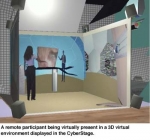
It's only the beginning of a revolution in virtual reality technology expected to take us by storm in the next decade or so, says Dr. Pierre Boulanger, a U of A computer scientist who just received an iCORE/TRLabs Industrial Research Chair worth a total of $1.7 million to develop his groundbreaking work in collaborative virtual environments.
Imagine a world, for example, where professors of surgery transmit hand and scalpel movements, as well as what they see while operating, thousands of miles across a computer network, where it is recreated in an operating room.
"The student will actually look at that and actually feel what the doctor is doing," said Boulanger. "On the other hand, the doctor can feel what the students are doing and give them a nudge in the right direction--It's like being in virtual residence with doctors."
Families separated by travel will spend meals together through what is called "telepresence," said Boulanger. "You would wear special goggles--and we're working on that--which would allow you to see your wife sitting in front of you, having a day-to-day conversation. In the future you will have virtual encounters like this, people you want to be part of a meeting sitting beside you virtually and having a conversation."
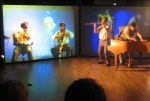
At a press conference on campus Tuesday to celebrate his chair, and that of Dr. Christoph Sensen at the University of Calgary, Boulanger explained how scientists are now able to create and manipulate a model of the earth's core by feeding computers highly sophisticated mathematical equations. Once recreated in 3D, the average person is fully capable of understanding such complex physical phenomena, he said. "People can actually interact with it, and say, "What happens if we have that instead of this?'"
"A three-dimensional visual model will allow you to explain complex systems, and understand how the world runs. People understand complex systems because daily life is actually very complex--the new technology is truly human-centred. Computers are smart enough today to adapt to people, and that's really a recent shift in computing."
The two chairs held by Boulanger and Sensen will focus on a variety of pursuits that will benefit from virtual reality technology, including engineering prototypes, testing medical procedures and conducting scientific research. Sensen, who has received $1 million for his research, is developing new tools to virtually work in the human body.
Boulanger was recruited to the University of Alberta's computing science department in 2001 from the National Research Council of Canada, where he spent 18 years as a senior research officer. He is also an adjunct scientist and principal investigator for new media at TRLabs, Canada's largest not-for-profit information and communications technology research consortium , and at the Banff Centre.
His new chair includes an iCORE Industrial Chair Establishment grant of $50,000 per year for five years, in addition to further grants from TRLabs, the University of Alberta, the Canada Foundation for Innovation, the Natural Sciences and Engineering Research Council, the Canadian Network for the Advancement of Research in Industry and Education and other industry partners.
"From my perspective, an absolutely essential part of Pierre's work on the collaborative virtual environment is described by the word collaborative," said dean of science Gregory Taylor. "It's at the very forefront of what I like to call the new science, interdisciplinary science where the collaborative team becomes the vehicle for discovery."
iCORE was established six years ago by the provincial government to support university research that supports information and communications technology. There are now 20 chairs focused on emerging areas such as wireless communications, artificial intelligence and quantum nanocomputing
15:45 Posted in Telepresence & virtual presence | Permalink | Comments (0) | Tags: Positive Technology, Presence
New lightweight LCD screen
From Gizmodo
I4U has a few details on an impressively lightweight LCD screen from Scalar Corp. that can be mounted on ordinary glasses that weighes a scant seven grams. The screen offers a simulated 14-inch screen with 180,000 pixels (roughly television resolution). It's not terribly expensive, either, at just $460 or so.
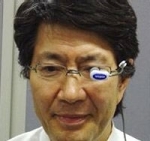
14:55 Posted in Wearable & mobile | Permalink | Comments (0) | Tags: wearable







